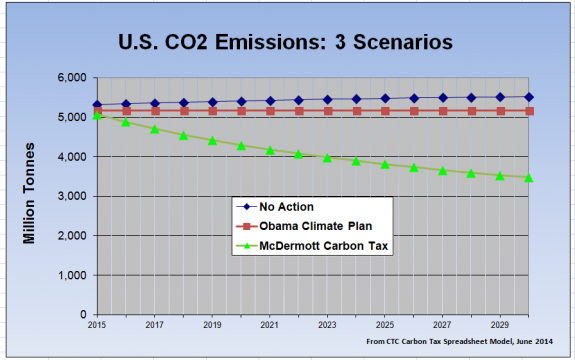By Charles Komanoff
We again welcome Charles Komanoff to EarthDesk, and his examination of President Obama’s recently released climate action plan. Charlie’s analysis is unlike most you will read. The majority of environmentalists have heaped praise on the plan. Other parties have declared it the end of democracy as we know it. Charlie looks at the math, and it does not come out well within the context of the emergency that climate advocates have warned about. This post first appeared at his Carbon Tax Center. More on Charlie at the conclusion. Read on.
Peel back the numbers and President Obama’s climate action plan turns out to be precious little. Relative to 2030 emissions projected from current trends, the drop in that year’s U.S. CO2 emissions sought by the President is a painfully modest 355 million tonnes (metric tons). That equates to just 7% of total actual emissions from all sources last year (5313 million tonnes).

White House’s 2030 CO2 Reduction Target: Just 7 Percent.
To be sure, the business-as-usual (no action) trajectory producing that 355 million tonne figure is mine, not the administration’s. (At the time I wrote this the White House hadn’t translated its percentage target into metric tons of CO2.) I derive it here, and it’s subject to argument.
What’s not debatable is that power plants are the low-hanging fruit in cutting CO2. That’s because electricity-sector CO2 emissions can be cut relatively easily not just via the demand side (through energy efficiency and conservation) but also on the supply side (by converting from coal to gas, and from coal and gas to renewables). Indeed, as of last year, demand and supply steps by industry, household and government had already wrought a 15% reduction in U.S. power plant emissions from the president’s 2005 base year (a drop of 361 million tonnes from 2414 million). By calling for only a second round of 15% cuts (355 million tonnes) from 2014 to 2030, the Obama plan in effect takes twice as long (16 years) to cut as much carbon pollution as the country just did (in 8 years, from 2005 to 2013).
Heaping praise on a policy to cut emissions just 7% over 16 years doesn’t square with treating global warming like the planetary emergency it is.
Here’s another way to see how undersized a CO2 cut 355 million tonnes is: in a different political universe, one in which a carbon tax could be made the economic engine for cutting CO2, that same reduction (355 million tonnes) could be effectuated through almost the tiniest carbon tax imaginable: a carbon pollution fee starting at $2.15 per ton of CO2 and rising by $2.15/ton each year, and applied only to the electricity sector (i.e., ignoring the other 61% of U.S. CO2 that comes from cars, trucks, planes, refineries, factories, heating, mining, etc., as the Obama plan does). Equivalently, an economy-wide carbon tax of just a buck and a quarter per ton of CO2 (rising by the same $1.25 each year) would also do the CO2-cutting job of the Obama plan. (These tax rates are derivable with my newly updated carbon tax spreadsheet model, which you can download here.)
So when the NY Times calls the Obama plan one of the strongest U.S. government actions ever taken on climate, that’s a sign of how low the bar has been set by our country’s history of inaction.
What to do? Two things.
First, lean on the environmental lobby to stop caving to the White House. We need prominent advocates like NRDC and EDF to insist on more. Yes, it can be difficult to talk tough to the President when even halting steps like today’s are viciously attacked by the dirty-energy lobby. But heaping praise on a policy to cut emissions just 7% over 16 years doesn’t square with treating global warming like the planetary emergency it is.
Second, get behind a carbon tax — a real one, like the $12.50/tonneCO2 tax (starting at that rate and rising annually at the same rate) that Rep. Jim McDermott (D-WA) is readying for introduction this week. Our modeling indicates that in its tenth year, the McDermott carbon tax (which equates to $11.34 per conventional “short” ton of CO2), would reduce U.S. CO2 emissions by a third from 2005 levels, and by nearly 30% from future emissions without the tax. (By 2030, the reductions would be 41% from 2005 and 37% from business-as-usual.) The local chapter of the Citizens Climate Lobby is an excellent vehicle for political action for this or other robust carbon taxes.
Like you, we know full well that a measure like McDermott’s can’t and won’t make it through this Congress, and perhaps the next, even though it could be folded into comprehensive tax reform, spurring economic growth by shifting tax burdens off work and investment and onto climate pollution. But seven percent won’t do. A robust carbon tax like McDermott’s is more essential than ever.
«« »»
 Charles Komanoff is director of the consulting firm Komanoff Energy Associates, ‘re-founder’ and president emeritus of the renowned advocacy group Transportation Alternatives, a founding trustee of the Tri-State Transportation Campaign, co-ordinator of the pedestrian-rights organization Right Of Way, and director of the Carbon Tax Center. His work combines expertise in policy analysis, a flair for expressing numerical and economic data in concrete terms, and a passion for progressive social change. He has advised Congress, non-profit organizations and government agancies. After 9-11, he published Ending The Oil Age, a detailed policy prescription for immediately reducing U.S. oil consumption by up to 10%. Komanoff graduated with honors from Harvard College with a B.A. in Applied Mathematics. More here. . .
Charles Komanoff is director of the consulting firm Komanoff Energy Associates, ‘re-founder’ and president emeritus of the renowned advocacy group Transportation Alternatives, a founding trustee of the Tri-State Transportation Campaign, co-ordinator of the pedestrian-rights organization Right Of Way, and director of the Carbon Tax Center. His work combines expertise in policy analysis, a flair for expressing numerical and economic data in concrete terms, and a passion for progressive social change. He has advised Congress, non-profit organizations and government agancies. After 9-11, he published Ending The Oil Age, a detailed policy prescription for immediately reducing U.S. oil consumption by up to 10%. Komanoff graduated with honors from Harvard College with a B.A. in Applied Mathematics. More here. . .









